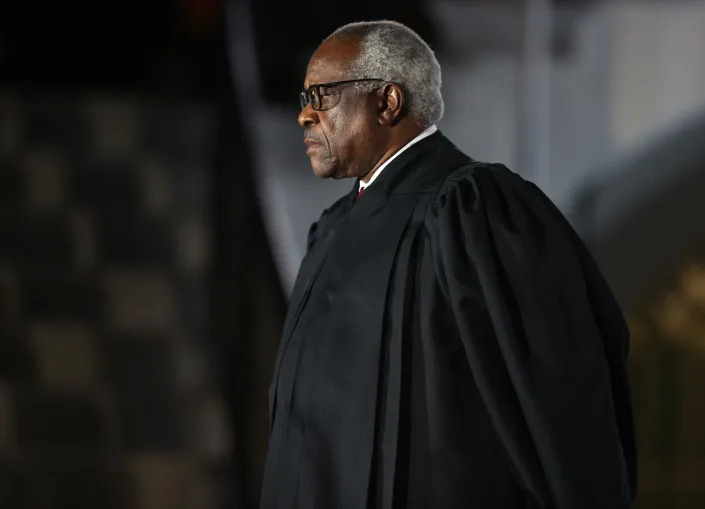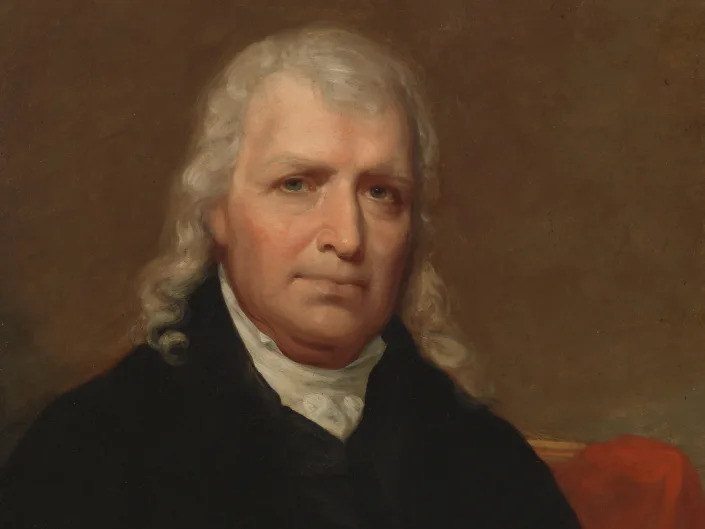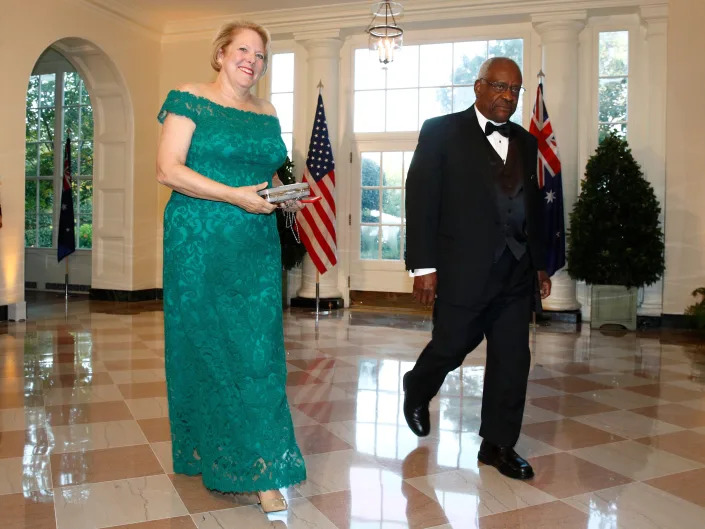Insider
Impeaching Clarence Thomas: How Democrats could remove conservative justices
C. Ryan Barber – June 27, 2022

- Democrats have increased calls to remove justices in response to the overturning of Roe v. Wade.
- Justice Clarence Thomas previously faced calls for impeachment in connection with January 6.
- Senators have questioned whether Justices Brett Kavanaugh and Neil Gorsuch lied about their views.
The many controversies and polarizing opinions spilling out of the Supreme Court in recent months have drawn calls for an event not seen in more than two centuries of American history: the impeachment of a sitting justice.
Even before Friday’s decision eliminating the constitutional right to an abortion, Democrats including Rep. Alexandra Ocasio-Cortez had voiced support for impeaching Justice Clarence Thomas, the longest-tenured sitting member of the Supreme Court. At the time, the demands for his removal centered on the revelation of more than two dozen text messages Thomas’ wife, Ginni Thomas, exchanged with onetime White House chief of staff Mark Meadows as she sought to help former President Donald Trump overturn the 2020 election.
And those calls intensified after Thomas joined with other justices in the Supreme Court’s conservative bloc to overturn Roe v. Wade, the nearly 50-year-old decision that established a constitutional right to an abortion. Other justices are now facing similar calls for impeachment amid questions about whether they misled the Senate during their confirmation proceedings about their views on Roe.
“I believe lying under oath is an impeachable offense,” Ocasio-Cortez said during a recent interview on NBC’s Meet the Press, referring to Trump-appointed Justices Neil Gorsuch and Brett Kavanaugh.
Indeed, eyebrows lifted on both sides of the aisle after the Kavanaugh and Gorsuch joined in the reversing Roe. Sen. Susan Collins, a Maine Republican who supported Gorsuch’s and Kavanaugh’s confirmations, said the decision was inconsistent with what the two justices said “in their testimony and their meetings with me, where they both were insistent on the importance of supporting long-standing precedents that the country has relied upon.”
Sen. Joe Manchin, a West Virginia Democrat, said he “trusted Justice Gorsuch and Justice Kavanaugh when they testified under oath that they also believed Roe v Wade was settled legal precedent, and I am alarmed they chose to reject the stability the ruling has provided for two generations of Americans.”
In his controversial concurring opinion in the abortion case, Thomas argued the Court should also “reconsider” rulings that established rights to same-sex marriage, access to birth control and gay sex.
Amid nationwide protests and anxiety over the potential rollback of those rights, a petition calling for Thomas’ impeachment continued to pick up support. The petition, organized in March by the advocacy group MoveOn, had received more than 300,000 signatures.

How to impeach a Supreme Court justice
The process of impeaching a Supreme Court justice is identical to the more well-tread procedure for removing a sitting president.
First, the House must draft articles of impeachment. The House then needs only a majority, however slim, to impeach a Supreme Court justice or any other federal judge. But a two-thirds majority is required in the Senate to convict.
Given the current political climate — Democrats have the thinnest majority possible, with a 50-50 Senate — it’s almost certain that Thomas wouldn’t be removed from his lifetime appointment. Republicans are enjoying a significant ideological majority on the Supreme Court, with six of nine justices.
What would be grounds for impeaching Thomas?
Given Ginni Thomas’ texts, some Democrats have noted that in January, Clarence Thomas stood out as the only justice to dissent when the Supreme Court rejected Trump’s bid to block the release of some presidential records to the House committee investigating the attempt to disrupt the peaceful transfer of power.
Thomas had previously dissented in February 2021 when the Supreme Court turned away election challenges filed by Trump and his political allies. Thomas described the decision to not hear the cases as “baffling” and “inexplicable,” saying in dissent that the Supreme Court should have taken the opportunity to provide states with guidance for elections.
Some Democrats in 2019 had clamored for the impeachment of Supreme Court Justice Brett Kavanaugh, but no serious impeachment effort in Congress ever materialized.

Federal judicial impeachments are rare
Federal judges, including those on the Supreme Court, have lifetime appointment — their tenures typically ending with retirement or death.
As a Brennan Center for Justice study noted in 2018, the impeachment of federal judges “is rare, and removal is rarer still.” The study found that the House had impeached only 15 judges since 1803 — an average of one every 14 years — and only eight of those proceedings resulted in convictions by the Senate.
The history of impeaching a Supreme Court justice requires a more than 200-year reach back into American history.
In 1804, Justice Samuel Chase went down in history as the first — and, so far, only — sitting member of the Supreme Court to be impeached when the House accused him of refusing to dismiss biased jurors and excluding or limiting defense witnesses in a pair of politically sensitive trials.
An official Senate website describes Chase as a “staunch Federalist with a volcanic personality” who “showed no willingness to tone down his bitter partisan rhetoric after Jeffersonian Republicans gained control of Congress in 1801.” Then-President Thomas Jefferson backed the impeachment effort.
But in 1805, Chase survived the impeachment proceedings after his legal team — including “several of the nation’s most eminent attorneys” — convinced enough senators that the justice’s conduct did not warrant removal from the Supreme Court, according to the Senate website. Chase continued serving on the Supreme Court and died in 1811.
In 2010, the Senate voted to convict Thomas Porteous, then a federal judge in New Orleans, after the House impeached him on allegations of bribery and making false statements. Other judges have resigned in the face of threatened impeachment and removal from their lifetime appointments.

A text-message brouhaha
Ginni Thomas’ text messages were among the more than 2,000 that Meadows turned over to the special House committee investigating the January 6, 2021, attack on the Capitol. The messages show how eagerly Thomas promoted and pushed to guide Trump’s strategy to overturn his 2020 electoral defeat.
In some of the messages, Thomas elevated the conservative lawyer Sidney Powell, who has since faced sanctions over her lead role advancing Trump’s baseless claims of election fraud.
“Sounds like Sidney and her team are getting inundated with evidence of fraud. Make a plan. Release the Kraken and save us from the left taking America down,” Thomas wrote in a November 2020 text to Meadows.
“Suggestion: You need to buck up your team on the inside, Mark,” Thomas wrote in another message. “The lower level insiders are scared, fearful or sending out signals of hopelessness vs an awareness of the existential threat to America right now. You can buck them up, strengthen their spirits.”
It is unclear whether the 29 messages — 21 sent by Thomas, eight by Meadows — reflected the extent of their communication.
Justice Thomas faced calls for his retirement or resignation even before his wife’s text messages with Meadows became public, as The New Yorker, The New York Times, and other media outlets illuminated his wife’s political activism.
But the text correspondence brought a new tenor to the pressure on Thomas to step down from the Supreme Court.
In March, Rep. Ilhan Omar, a Minnesota Democrat, wrote in a Twitter post that “Clarence Thomas should be impeached.”
Ocasio-Cortez threatened Thomas with impeachment if he refused to resign.
“Clarence Thomas should resign,” the New York Democrat wrote on Twitter. “If not, his failure to disclose income from right-wing organizations, recuse himself from matters involving his wife, and his vote to block the Jan 6th commission from key information must be investigated and could serve as grounds for impeachment.”
Meanwhile, other lawmakers have called for Justice Thomas to recuse himself from cases related to January 6.
Sen. Dick Durbin, the top Democrat on the Senate Judiciary Committee, said the text message correspondence “raises a serious question about conflict of interest for Justice Thomas.”
“To think that he would consider a case where his wife is frequently contacting the chief of staff for the president and giving advice on matters that are going to be ultimately litigated by the court,” Durbin told reporters on Capitol Hill. “For the good of the court, I think he should recuse himself from those cases.”
Sen. Ron Wyden, an Oregon Democrat, called on Thomas to recuse himself from cases involving the Capitol-riot investigation and 2024 election because his “conduct on the Supreme Court looks increasingly corrupt.”
President Joe Biden, however, declined to call for Justice Thomas to recuse himself from such cases.
House Minority Leader Kevin McCarthy said it would be up to Thomas to decide whether to recuse himself from cases involving the investigation into January 6, 2021.
In an interview with The Washington Free Beacon, Ginni Thomas said, “Clarence doesn’t discuss his work with me, and I don’t involve him in my work.”
But in a 2011 speech, Clarence Thomas appeared to link his service on the Supreme Court to his wife’s political advocacy.
“We love being with each other because we love the same things. We believe in the same things … We are focused on defending liberty. So I admire her and I love her for that because it keeps me going,” Thomas said.
